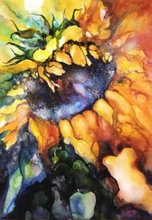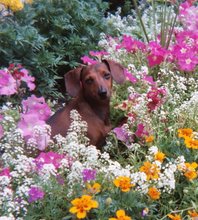The tips of the ears are acupressure points for shock and colic. Gently pulling the entire ear and then rubbing the tip between the thumb and forefinger is very helpful. It is not really necessary to worry about knowing the exact location of these acupressure points. Working anywhere on the inside of the ear will be useful in helping a sick animal to recover or keep a healthy animal well. Even though some animals do like to have their ears touched, working on them is still important as it will often help suffering. You can even help yourself by working your own ears if you have overeaten or are suffering from colic. Keeping an animal from going into shock can make the difference in his living or dying and will help an overstressed horse to recover. If you encounter a shock or colic situation - try it - you will not harm the animal and you will likely help a great deal.
Ear TTouch
The ear, especially at the tip, contains acupressure points along the Triple Heater Meridian. This meridian wraps around the ear and runs across the shoulder and down the front leg and hoof. Activating these pressure points can effect positive change in respiratory, digestive and reproductive systems. This is a key point for the amelioration of shock. I have used it myself in horses, dogs, and human beings with great success. Linda Tellington-Jones says: “It has prevented what I believe would have been the possible death of my pug and the diversion of a trans-pacific flight, awakened a passed out girl in a farmer’s market in Kona, Hawaii, and reversed an equine colic.” Try it. You have nothing to lose if the vet is already on his way, and you might just turn the colic around. If not, then you have taken steps to calm the horse and increase his comfort level during a stressful and painful time. According to Linda Tellington-Jones, ear slides date back to the stagecoach days, when they were commonly used for faster recovery after hard, fast work.
Working a horse's ears has many different uses: It can help a colicking horse to calm down (while you are waiting for the vet). Ear TTouch is being used by endurance riders to lower a horse's pulse and respiration during races. It improves circulation, helps your horse to relax and is most useful when your horse is in shock or under stress. I have found it very helpful for foaling mares, easing their pain and helping them recover faster.
The ears and the base around them have many acupressure points. The triple warmer meridian is located around the base of the ear.
By working this acupressure meridian you affect the digestive, pulmonary and reproductive systems. At the tip of the ear is a shock point. Making small circles with your thumb and forefinger will greatly help your horse recover from shock and help him stabilize.
Here is how you get started:
Stand in front of your horse and hold the side of the halter with one hand. Your horse's head should be lowered. With the other hand gently explore the area around the ear. Move your fingers in tiny circles with light pressure, but enough contact to move the skin in a tiny circle. You can practice this on your own arm first. Make a tiny circle, taking care to not just slide your finger over the skin, but actually pushing the skin in a circle.
"Ear Slides", are also very effective. Gently but firmly stroke the ear away from the base to the tip. It works well to hold the halter on the opposite side of the ear you are touching. You can also make tiny connected circles in lines from the base to the tip of the ear. It is great to work the inside of the ears, starting by taking the edges gently between your thumb and forefinger and making circles all over them.
As you do this make sure you stand comfortably, breathe easily and keep your fingers soft. Pay close attention to your horse. He will let you know when you are pressing too hard by raising his head and not holding still.
Licking, chewing, and closing his eyes are signs of the horse enjoying the ear work. Most horses love to have their ears worked, but there are horse who don't like their ears touched. Then you start by working towards them slowly, making the circles through a washcloth or using the back of your hand to touch.
It is well worth the effort to get your horse used to having his ears touched. This is not only useful for easier bridling, but also for doing the ear Touch to ease mental or physical tension. This TTouch is especially effective between classes at a horse show, at rest stops on an endurance race and during or after any stressful workout.
Knowing how to do this will give you a wonderful tool to help your horse in difficult situations and also enrich and deepen the relationship between you and your horse.
The tips of the ears are acupressure points for shock and colic. Gently pulling the entire ear and then rubbing the tip between the thumb and forefinger is very helpful. It is not really necessary to worry about knowing the exact location of these acupressure points. Working anywhere on the inside of the ear will be useful in helping a sick animal to recover or keep a healthy animal well. Even though some animals do like to have their ears touched, working on them is still important as it will often help suffering. You can even help yourself by working your own ears if you have overeaten or are suffering from colic. Keeping an animal from going into shock can make the difference in his living or dying and will help an overstressed horse to recover. If you encounter a shock or colic situation - try it - you will not harm the animal and you will likely help a great deal.
Read more articles of interest by Yvette Eastman at www.touchpointreflexology.com



















No comments:
Post a Comment